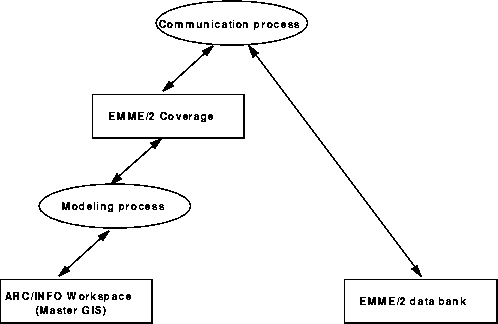
INRO Consultants established guidelines to standardize the creation of a transportation planning coverage and developed a set of tools to transfer information between EMME/2 and ArcInfo.
In this paper, we identify the motivation for the development of a data exchange procedure between ArcInfo and EMME/2. Then we identify the corresponding data items in ArcInfo and EMME/2, discuss the communication process for exchanging data and computed results between the two systems, and develop a user-friendly interface to realize the data exchange. As a concrete example, we present a prototype of the system for the EMME/2 road and transit network, which can be used to display the attributes and results obtained in EMME/2. Future developments and possible applications of this system are discussed as well.
Unfortunately, for the purposes of transportation planning, they offer a limited set of tools. The transportation planner deals with an aggregate representation of networks (current and future) and wants to compare different scenarios in order to make a recommendation. This information cannot be obtained from a typical GIS. To assist the planner in more complex and specific tasks other software packages, like EMME/2, offer a working environment that incorporates some spatial data manipulation features and, above all, provide strong network assignment and demand modeling capabilities.
Since much effort is usually invested in the creation of databases (be it at the city, county, or state levels) to manage spatial information within a GIS, it would be beneficial to be able to share data and analysis results in order to expand the database.
It is costly to maintain different databases for different applications in different departments. Therefore, the goal is to integrate these databases into a common multi-purpose database. Our efforts serve as a contribution towards the compatibility of spatial information, as requested by the GIS community.
In this paper we consider ArcInfo as the GIS software package, and EMME/2 as the transportation planning software package.
EMME/2 stores information in a "vertically" structured data format (each element attribute, such as link length, is stored in a vector). Compared to a "horizontal" structure, where a row in a table contains all the attributes of an element, a "vertical" one makes efficient use of the available computer memory space and also drastically reduces the number of disk accesses required to quickly and selectively access the EMME/2 data bank.
| Objects | ArcInfo items | EMME/2 items |
| street | route | - |
| street section | section | - |
| directed street section | arc | link |
| intersection | node | node |
| traffic light | node | node |
| transit line | route | line |
| transit section | section (within a route) | segment (within a line) |
| transit stops | point event, node | node |
| region | region | zone, group, ensemble |
| TAZ (traffic analysis zone) | polygon | zone |
| Origin and Destination | node, center | centroid |
| O-D matrix | - | matrix |
| supply center | node | centroid |
| demand center | node | centroid |
| turns | turn (arc-node-arc) | turn (at_node-from_node-to_node) |
| arc-to-arc barrier | arc selection set | turn penalties |
| drawing | polyline, patterns | annotation, demarcations |
| text | annotation | annotation |
| ArcInfo | EMME/2 | ||
| - | arcs can be bidirectional (with directional attributes) | - | links are unidirectional (represent flow of traffic) |
| - | each arc can be composed of up to 500 vertices, including from-node and to-node | - | each link is composed of an i-node (from-node) and a j-node (to-node) |
| - | a node is created by the CLEAN command when two arcs crossover (polygon topology) | - | links can pass one over another |
| - | bus stops can be stored as point events which are not necessarily represented by nodes at the arc-node level | - | bus stops must be represented by a node |
| - | all feature attributes are stored in a relational-like data base ("horizontal" structure) that is managed by the INFO information manager (or other external relational data base managers) | - | element attributes are stored in a "vertical" structure |
| - | tables are mostly user-defined depending of the user applications and data needs | - | many of the attributes are already defined (standard attributes) |

The EMME/2 data bank is an aggregate representation of the transportation infrastructure, the economic activities and the socio-economic characteristics of the urban area studied.
The EMME/2 coverage follows the EMME/2 network representation. This implies:
The modeling process represents the transformation of the user network in the master GIS into the EMME/2 coverage. This can be complex or simple depending on the design of the database. In order to create the EMME/2 coverage from an existing master GIS, the planner has to take a road network coverage and convert it into an aggregate representation by removing unnecessary details, merging some arcs together and reevaluating attributes. Also, if the transportation network includes a transit network, the planner has to take the route-system representing transit lines and split underlying arcs at bus stops to create a node. This process must include a procedure to keep the correspondence between the user network and the base network of the EMME/2 coverage. The modeling process is specific to the organization where it is implemented.
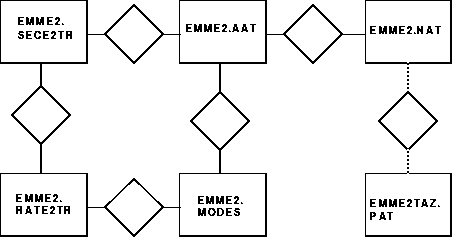
The EMME2.NAT table stores information related to nodes. The first two fields of this table contain internal information, also created when building the arc-node topology, and are maintained by ArcInfo. The EMME2-ID field is used to store the EMME/2 node number. Again, if the EMME/2 coverage is derived from an existing user coverage in the master GIS, then this number is already present, and can be directly used as the node identifier in EMME/2. However, if the EMME/2 coverage is derived from an EMME/2 network, this identifier should be computed using the relation between FNODE# and TNODE# fields of the EMME2.AAT table, and the EMME2# field of the EMME2.NAT table. Since the INODE and JNODE fields of the EMME2.AAT table contain the EMME/2 node number and are related to the FNODE# and TNODE# respectively, the EMME2-ID is computed as follows:
The EMME2.MODES table is used as a lookup table for the transportation mode definitions, and is maintained by the user. It may be used for query purposes of mode on arcs (EMME2.AAT) or transit lines (EMME2.RATE2TR). It could be directly obtained from the EMME/2 mode definitions. The table definition of EMME2.MODES can be found in Appendix A.
The EMME2.RATE2TR table stores information about transit line definitions, while the EMME2.SECE2TR table is used to store information about transit line segments. The first field of RAT and the first seven fields of the SEC table are maintained by ArcInfo and are created when a route-system is built. Because we decided to keep a one-to-one relationship between a section and an arc, we have the same relationship between a section (in ArcInfo) and a segment (in EMME/2). The E2TR-ID field of the EMME2.SECE2TR table is used to store a unique section identifier number which assures the correspondence between a section in ArcInfo and a segment in EMME/2. If the EMME/2 coverage is derived from an existing user coverage in the master GIS, then this number is already present, and can be directly exported to an extra attribute in the EMME/2 data bank. However, if the EMME/2 coverage is derived from an EMME/2 network, this identifier must be evaluated in EMME/2. One needs to compute the identifier based on the internal segment index of the EMME/2 data bank and keep the result in an extra attribute (by default @segid). The E2TR-ID is computed as follows: for each transit line, the value of each segment within the line is assigned to the internal segment number plus the value of a variable; this variable contains the maximum segment value of the previous transit line evaluated. We thus obtain a unique value for each segment within all transit lines. This is easily done with an EMME/2 macro.
The ROUTE-ID field (of the EMME2.SECE2TR table) contains an integer value representing the transit line number. It is equivalent to the E2TR-ID field of the EMME2.RATE2TR table. In EMME/2, transit lines are identified by a six character string (LINENAME field of EMME2.RATE2TR table) while in ArcInfo a route is identified by an integer. When exporting to EMME/2, the ROUTE-ID can be directly used as the transit line identifier in EMME/2. When exporting from EMME/2 to ArcInfo, however, a unique numeric line identifier must be computed from the internal line number. The table definitions of EMME2.RATE2TR and EMME2.SECE2TR are in Appendix A.
The EMME2.TRN table stores information related to turns and is created by the TURNTABLE command. The first seven fields of the TRN table contain internal information and are maintained by ArcInfo. The TURN-ID field contains a unique value for each turn, and is evaluated with the expression: ARC1-ID * 100000 + ARC2-ID. It is used to facilitate the joining of attribute tables if specific turn attributes are coming from the EMME/2 data bank. The table definition of EMME2.TRN is in Appendix A.
The EMME2TAZ.PAT feature table stores information related to traffic analysis zones. The first three fields of this table are standard and contain internal information. They are created by ArcInfo when building the polygon topology. The EMME2TAZ-ID field is used to store a unique zone identifier number in order to keep the correspondence between a polygon in ArcInfo and a zone in EMME/2. Since this zone number is also related to the centroid number, you can relate information from the EMME2TAZ.PAT table and the EMME2.NAT table. If the polygon data is coming from an EMME/2 annotation file, the centroid number must be indicated at the beginning of the polygon definition. Appendix A contains the table definition of EMME2TAZ.PAT.
Other attributes (assignment results, extra attributes, ...) can be added as an additional column in the corresponding table. The name of the column should be the same as the name found in EMME/2.
We have chosen to store the road network information in the AAT instead of in a route-system since it is closest to the one-to-one relationship and since many ArcInfo users are probably familiar with the NETWORK data model.
The base network and related attributes
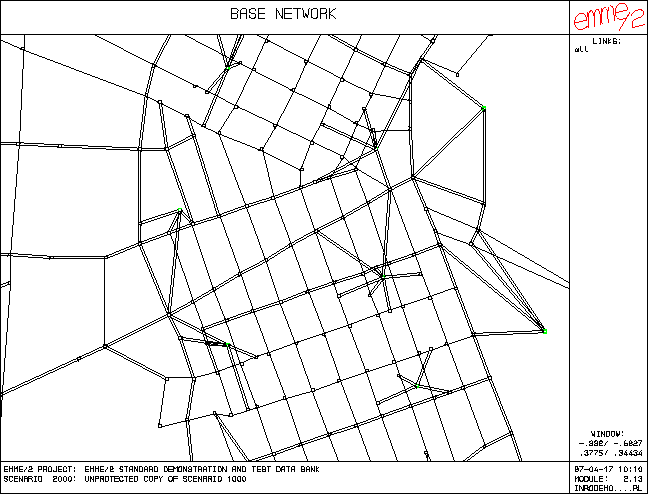
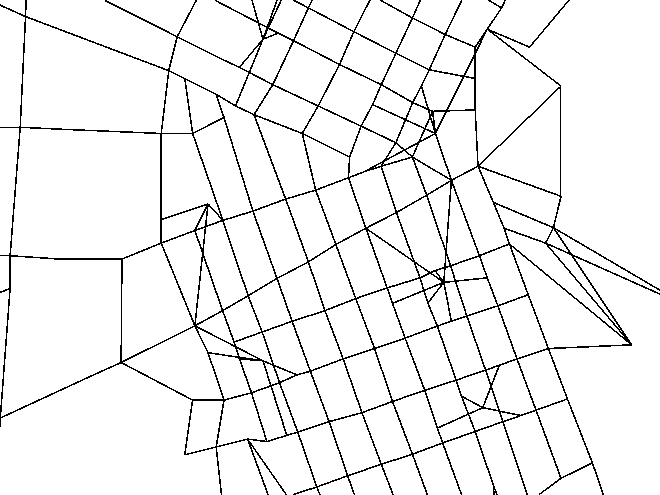
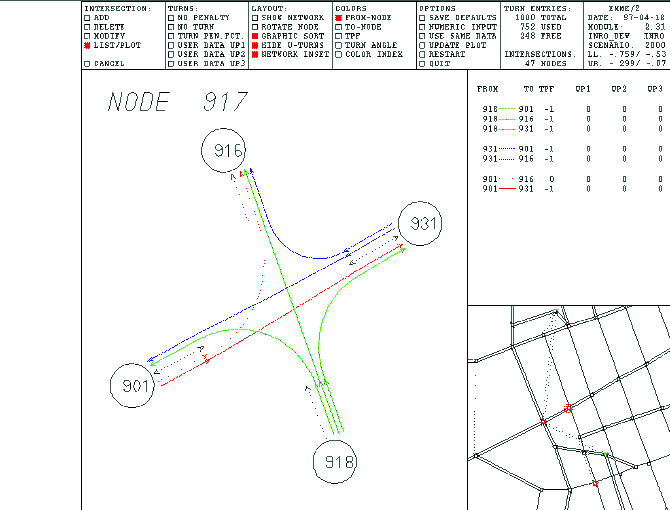
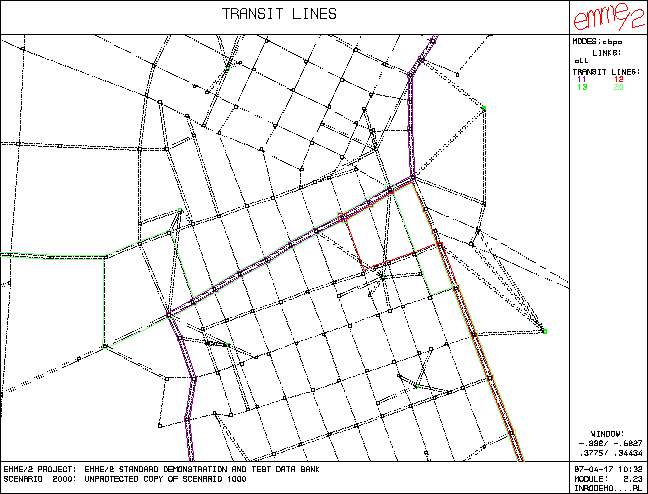

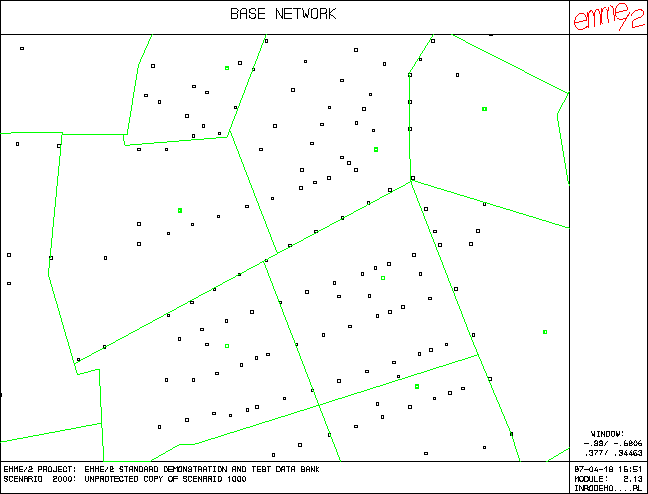
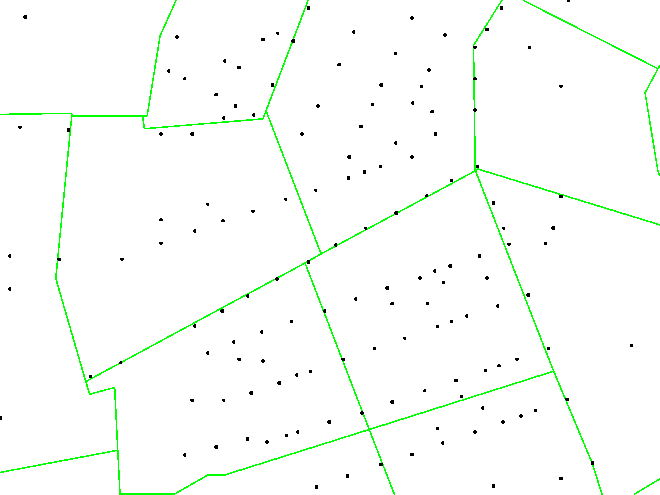
The whole exporting process takes about 100 seconds (on a SPARC 1000E) to transfer the same small network (150 zones, 1607 arcs, 67 transit lines, and 4205 line segments).


The data exchange process described here is static in nature and does not address the dynamic aspect of the problem: if small modifications are made in one data bank, the complete data set must be exported again. However, we see the current communication process as a necessary starting point toward a dynamic conncection.
Esri Limited, ArcDoc ver. 7.0.4, Redlands, CA, USA, 1995.
DATAFILE NAME: EMME2.AAT 03/12/1997
27 ITEMS: STARTING IN POSITION 1
COL ITEM NAME WDTH OPUT TYP N.DEC Description
1 FNODE# 4 5 B - Internal node number of the
from-node of the arc
5 TNODE# 4 5 B - Internal node number of the
to-node of the arc
9 LPOLY# 4 5 B -
13 RPOLY# 4 5 B -
17 LENGTH 4 12 F 3
21 EMME2# 4 5 B -
25 EMME2-ID 4 5 B - A unique arc identifier number which
assures the correspondence between an
arc in ArcInfo an a link in EMME/2
29 INODE 8 8 I - EMME/2 node number for the from-node
37 JNODE 8 8 I - EMME/2 node number for the to-node
45 LEN 4 12 F 3 EMME/2 link length
49 LENR 4 12 F 3 Same as above for the opposite direction
53 LANES 4 8 F 1 Number of lanes
57 LANESR 4 8 F 1 Same as above for the opposite direction
61 TYPE 6 6 I - EMME/2 link type
67 TYPER 6 6 I - Same as above for the opposite direction
73 VDF 6 6 I - EMME/2 volume delay function number
79 VDFR 6 6 I - Same as above for the opposite direction
85 UL1 4 8 F 2 EMME/2 user defined link data
89 UL1R 4 8 F 2 Same as above for the opposite direction
93 UL2 4 8 F 2 See UL1
97 UL2R 4 8 F 2 See UL1R
101 UL3 4 8 F 2 See UL1
105 UL3R 4 8 F 2 See UL1R
109 MODE 6 6 C - List of modes allowed on the link
115 MODER 6 6 C - Same as above for the opposite direction
121 SYMBOLS 4 8 F 2 Information used by the plotting routine of the prototype
125 SYMBOLSR 4 8 F 2 Same as above for the opposite direction
DATAFILE NAME: EMME2.NAT 03/12/1997
9 ITEMS: STARTING IN POSITION 1
COL ITEM NAME WDTH OPUT TYP N.DEC Description
1 ARC# 4 5 B -
5 EMME2# 4 5 B -
9 EMME2-ID 4 5 B - EMME/2 node number
13 CENTROID 4 5 B - Centroid indicator
17 UI1 4 8 F 2 EMME/2 user defined node data
21 UI2 4 8 F 2 See UI1
25 UI3 4 8 F 2 See UI1
29 LABEL 6 6 C - Optional node label
DATAFILE NAME: EMME2.MODES 03/24/1997
9 ITEMS: STARTING IN POSITION 1
COL ITEM NAME WDTH OPUT TYP N.DEC Description
1 MODE 1 1 C - EMME/2 mode identifier
2 DESCRIPTION 10 10 C - Mode description
12 TYPE 4 4 I - Number which identifies the type
(auto (1), transit (2), auxiliary
transit (3) or auxiliary auto (4))
16 PLOT 4 4 I - EMME/2 plot code
20 CTC 4 8 F 2 Operating cost/hour factor
24 CDC 4 8 F 2 Operating cost/length unit factor
28 ETC 4 8 F 2 Energy consumption/hour factor
32 EDC 4 8 F 2 Energy consumption/length unit factor
36 SPEED 4 8 F 2
DATAFILE NAME: EMME2.RATE2TR 03/12/1997
11 ITEMS: STARTING IN POSITION 1
COL ITEM NAME WDTH OPUT TYP N.DEC Description
1 E2TR# 4 5 B -
5 E2TR-ID 4 5 B - Line identifier
9 LINENAME 6 6 C - EMME/2 line name
15 MODE 2 2 C - Mode of the line
17 VEH 6 6 I - Vehicle type for this line
23 HEADWAY 4 8 F 2 Vehicle headway in minutes
27 SPEED 4 8 F 2 Vehicle default speed in length
units per hour
31 DESCRIPTION 20 20 C -
51 UT1 4 8 F 2 EMME/2 user defined line data
55 UT2 4 8 F 2 See UT1
59 UT3 4 8 F 2 See UT1
DATAFILE NAME: EMME2.SECE2TR 03/12/1997
19 ITEMS: STARTING IN POSITION 1
COL ITEM NAME WDTH OPUT TYP N.DEC Description
1 ROUTELINK# 4 5 B -
5 ARCLINK# 4 5 B -
9 F-MEAS 4 12 F 3
13 T-MEAS 4 12 F 3
17 F-POS 4 12 F 3
21 T-POS 4 12 F 3
25 E2TR# 4 5 B -
29 E2TR-ID 4 5 B - A unique section identifier
number which assures the correspondence
between a section in ArcInfo and
a segment in EMME/2
33 ROUTE_ID 4 5 B - Line identifier
37 DWT 4 8 F 2 EMME/2 dwell time per line segment
in minutes
41 DWTF 4 8 F 2 EMME/2 dwell time factor in minutes
per length unit
45 NOALI 4 4 I - EMME/2 indicator for no-alighting
49 NOBOA 4 4 I - EMME/2 indicator for no-boarding
53 TTF 4 4 I - EMME/2 transit time function on
number on links and turns
57 TTFT 4 4 I - EMME/2 transit time function
number on turns
61 US1 4 8 F 2 EMME/2 user defined segment data
65 US2 4 8 F 2 See US1
69 US3 4 8 F 2 See US1
73 LAY 4 8 F 2 Layover time in minutes
DATAFILE NAME: EMME2.TRN 03/12/1997
14 ITEMS: STARTING IN POSITION 1
COL ITEM NAME WDTH OPUT TYP N.DEC Description
1 NODE# 4 5 B -
5 ARC1# 4 5 B -
9 ARC2# 4 5 B -
13 AZIMUTH 4 12 F 3
17 ANGLE 4 12 F 3
21 ARC1-ID 4 5 B -
25 ARC2-ID 4 5 B -
29 TURN-ID 10 10 I - A unique indentifier for each turn
39 ARCID1 5 5 I - Identifier of the from-arc (see
EMME2-ID in EMME2.AAT)
44 ARCID2 5 5 I - Identifier of the to-arc (see
EMME2-ID in EMME2.AAT)
49 TPF 8 8 F 2 EMME/2 turn penalty function number
57 Up1 8 8 F 2 EMME/2 user defined turn data
65 Up2 8 8 F 2 See Up1
73 Up3 8 8 F 2 See Up1
DATAFILE NAME: EMME2TAZ.PAT 03/24/1997
6 ITEMS: STARTING IN POSITION 1
COL ITEM NAME WDTH OPUT TYP N.DEC Description
1 AREA 4 12 F 3
5 PERIMETER 4 12 F 3
9 EMME2TAZ# 4 5 B -
13 EMME2TAZ-ID 4 5 B - A unique zone identifier number
which assures the correspondence
between a polygon in ArcInfo and
a zone in EMME/2
17 COLOR 4 4 I - EMME/2 color code
21 PATTERN 4 4 I - EMME/2 line pattern code
| Robert Lussier, M.Sc. Information Systems Analyst INRO Consultants, Inc. 5160, Decarie Boulevard, suite 610 Montreal, Quebec H3X 2H9 Telephone: (514) 369-2023 Fax: (514) 369-2026 Email: robert@inro.ca | Jia Hao Wu, Ph.D. Senior Analyst INRO Consultants, Inc. 5160, Decarie Boulevard, suite 610 Montreal, Quebec H3X 2H9 Telephone: (514) 369-2023 Fax: (514) 369-2026 Email: wujiahao@inro.ca |